by Mary Dickinson, Arena Director/Producer (1984 – 2003)
I first worked on Arena not as a director but as a trainee assistant film editor in 1977. Arena was still in its original, magazine format at the time, but in 1979 it changed to single, director led film essays. Since leaving the Royal College of Art Film School, my overriding ambition was to direct rather than edit – and in particular to direct arts documentaries as prior to the RCA I studied fine art.
Even as an assistant editor, Arena felt very inclusive, your opinion mattered and for many years, the sense of working as a team continued. Often, when a film was approaching its final stages in an edit, there would be a “group viewing” which could include anyone from the Arena office who happened to be in on that day.
Aside from a short research attachment to the arts magazine Mainstream and a couple of directing opportunities on 100 Great Paintings, I was in the Arena cutting room until 1981. By this time the single film format for which Arena was to become famous was established.
To get into production, I had to move away from editing to the BBC’s Community Programmes Unit where I cut my teeth as a director and got some good experience under my belt. I made films about a diverse range of subjects including a film with Alexei Sayle for Comic Roots (26.6.83) in which I filmed Alexei telling the story of his roots via a pub crawl from Liverpool to London. It was a bit like a mini Arena in terms of how it was made. The last film I made for CPU was about Rape which was shot from the victim’s perspective using POV camera and voice over.
After the transmission of Rape in October 1984, I was given the opportunity to work on Arena as a director and moved into to the purpose built offices in Kensington House.

The Arena office in BBC Kensington House 1994
Searching for an idea, I came up with The Old Kent Road. I went for a recce, talked to some local people, took a few Polaroid photos, wrote a proposal and Alan Yentob liked it enough to give me the green light to go ahead.
The film was a contemporary look at part of the original road to Canterbury (now the A2). It was a tapestry of great characters and used archive and specially shot footage to illustrate. Crucially, for me, there was to be no “voice of god” commentary, so I began and ended the film with a reading from Chaucer’s Canterbury Tales. The narrative then continued via the contributors themselves with, as close as possible, an eye line down the lens rather than the standard three quarter profile as was customary at the time. The brilliant Mark Day was the film editor.
We were half way through the edit when Alan Yentob left Arena to become Head of Music and Arts and handed over the reins of the series jointly to Anthony Wall and Nigel Finch. It was Anthony who came into The Old Kent Road cutting room to review the various cuts before it was transmitted in 1985.
This was the beginning of nearly twenty, happy and highly creative years for me as a staff producer/director on Arena. Under this unique umbrella, Anthony (and Nigel until he died in 1995) created an energetic and exciting environment in which to work, carefully constructing each series from their ever changing list of subjects until they found the perfect ingredients.
Within a wide framework of arts, music and popular culture, each Arena film was quite different in terms of its style and presentation, but there was always an originality of thought in terms of how it was made. The subject matter could come from anywhere; the original idea didn’t necessarily have to be yours. As a director you created its form, structure and narrative flow and oversaw the filmmaking process from “soup to nuts” whilst periodically discussing ideas with Anthony until the film was completed.
Another of my early films, The Confessions of Robert Crumb (TX 1986) was a biographical idea suggested by Robert McNab, a Music & Arts assistant producer, who had a passion for underground comics. My twist away from the traditional arts biopic at the time, was for Crumb to tell his own story and illustrate it via his autobiographical comic strips - a bit like my Comic Roots with Alexei Sale. Robert and I met Crumb and between us persuaded him to embrace the idea, which he and his wife Aline did wholeheartedly.
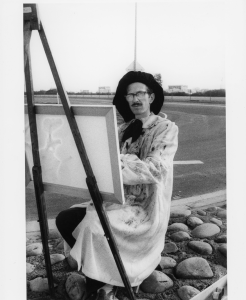
The Confessions of Robert Crumb (1985)
At that time, filmmaking was, by necessity, a team effort. The 16mm kit was complex and cumbersome and film crews needed years of training. The director always chose who was going to shoot and edit their film. Each of these individuals were experts in their field and we all had our favourites. My own favoured cameraman after the Crumb filming was the late Colin Case.
The Arena film editors were also very special. Certainly until editing went digital, a director would spend about 12 weeks in a 16mm cutting room on a 60 minute film with their editor - you’d better like each other. However editing an Arena wasn’t just about getting along. The sheer physicality of the editing process on film gave you time to review, think and re-assess the ideas. It was an organic process and an opportunity to discover new meaning and make connections in the footage, that could link and interweave seamlessly with the original narrative. Like all our editors on Arena, Colin Knijff was a master at this. Amongst the films he cut for me was The English Thoroughbred (TX 1988) A fantastic opportunity, handed to me by Anthony and Nigel, to layer several parallel narratives and connect ideas about class, culture, sport, history, art and tradition.

The English Thoroughbred (1988)
Like most directors, I’d go into the cutting room with fully marked up transcripts and my own paper “paste up” of the first cutting order, an archaic idea nowadays. Inevitably, when making a film about a phenomenon, idea or concept, the form can be elusive. Where do you begin and where do you end? Editing an Arena was often an exciting journey as we’d adapt and innovate to find the perfect pathway through the story.
The English Rose (1990) was another of my early films shot by Colin but this time cut by Arena editor Guy Crossman. Like The Thoroughbred, it was a layered film, this time combining cultural concepts of femininity, folklore, history, horticulture, art, literature and religion.
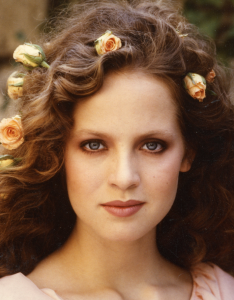
The English Rose (1990)
Anthony’s choice of directors, be they staff, freelancers or independents, was very particular indeed. There was no doubt, that those of us who were lucky enough to make an Arena, had something in common – call it “attitude” if you like, but it was certainly the way you thought about the subject and constructed the film that made it an Arena and got you the gig.
Masters of The Canvas (TX 1992) was brought to us by outside freelance producer, Paul Yates. Taken from a Sunday Times article which asked various celebrities who they would like to be, the film was about the artist Peter Blake and his fantasy to be the masked wrestler Kendo Nagasaki. Again, it was a classic example of a good idea that as a director, I could twist, turn and adapt into something magical. Also shot by Colin Case but edited this time by David Kitson with Emma Mathews as his assistant.
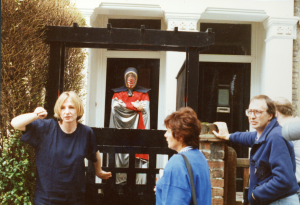
Filming Masters of the Canvas (1992) with Kendo Nagasaki, cameraman Colin Case (right) and my assistant Ann Mendelssohn (centre right)
For many years Anthony fought tooth and nail to preserve Arena’s independence of thought and position as the flagship Music & Arts series. As time went by and the BBC’s corporate structure changed, the commissioning process got more complicated and layered within the BBC’s hierarchy. However under Anthony’s “protection,” as a director, you could still make an individual film in the way you wanted - and he was very much with you all the way.
For me, as a producer/director, the bottom line was about what I could do with a subject that would elevate it above and beyond the norm in terms of documentary arts filmmaking - subverting the traditional documentary form wherever possible. Pictures were often more important than words, as were the pauses. I think this approach was very much influenced by my time at the RCA film school where there was an emphasis on experiment. Certainly some of the techniques of re-filming I used in Masters of the Canvas and in my later films come from this period.
I was particularly interested in making films about the abstract rather than the particular. Cigars – Out of the Humidor (TX 1997), was an idea brought to us by another freelancer, Pam Esterson. Crucially, for me, It was about the myth of the Cuban cigar and its desirability as a symbol of wealth and power in western culture. The partnership with Pam was a good one. Another film, about Cuban baseball, A Diamond In the Rough (TX 1999) was an idea we had on a day off from filming Cigars - whilst shopping for our kids in Havana. Ideas can, indeed, come from anywhere at any time.
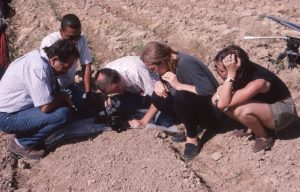
Cigars out of the Humidor (1997) – filming in Pina del Rio, Cuba, with our local crew, Colin Case (centre) and Pam Esterson (right)
My starting point has always been, “There’s the obvious way to make this film and there is another way...”. I was never interested in making a film like an illustrated lecture and wanted to enhance the experience of the television audience.
This “personal manifesto” fitted into the established Arena concept of the early 80’s and thereafter perfectly. These parameters would make you find other ways of expressing something - a case of thinking laterally.
Although he never said it to me personally, Anthony was once quoted as saying to one of the other directors “do you think you could make it less obvious?” I think it’s fair to say that the approach on Arena was not obvious but oblique. The intent, for me, was to actively engage the audience not only in the content but also in the grammar of the film’s construct.
Radio Night (18.12.93), one of several themed evenings I worked on with Anthony, was a case in point. A first in TV broadcasting, this interactive simulcast on BBC2 and Radio 4 could only be experienced fully if the radio and television were turned on in the same room, as the soundtrack was split between the two. The TV and Radio each had individual characters, played by Peter Cook and Josie Lawrence, who actively engaged in conversation and argument whilst linking a host of individual films and programmes across both media. A golden opportunity for some friendly rivalry – exemplified by our manufacture of the 9 o’clock “watershed” which I filmed with Pete Wane, Arena’s graphic designer.
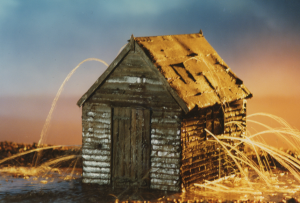
Radio Night (1993) The Watershed
Buffalo Bill’s Wild West – How the Myth was Made (TX 2003) was the last film I made for Arena. It was a deliberate attempt to challenge the artifice of the dramatic sequence within the TV documentary form. Bill Cody (AKA Buffalo Bill) started his career as a scout for the US army in its conquest of the American West. When all was done and city folk felt a sense of nostalgia for the “Old West”, he found that re-enacting the battles was something of a money earner. He took his Wild West Show across America, the UK and Europe, finally putting the whole thing on film with himself as the star. My film for Arena, cut by Joyce Gentle, was narrated in the first person and analysed by the author Richard Slotkin, whilst simultaneously exploring the artifice of performance.
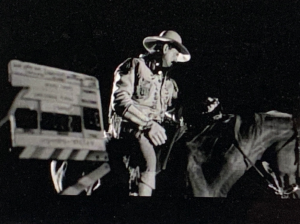
Buffalo Bill How the Myth was Made (2003) Screen still
Working on Arena was undoubtedly a privilege. It was the kind of creative working environment that was a way of life. Long hours, especially in the edit, were the norm but you were working with a great team and we were all dedicated to making the best and most interesting films possible. Each one was different but each was distinctly an Arena, with an attitude and a direction of thought you wouldn’t see anywhere else on television at that time.
About the Author
Mary Dickinson is a British documentary and experimental filmmaker and series producer.
Born in Balham, South West London, she studied Fine Art at Maidstone College of Art and then received an MA from the Royal College of Art School of Film and Television.
She joined the BBC’s editing department in 1977 and became a director in the Community Programmes Unit in 1981. She moved to Arena in 1984 and as a director/producer worked across the strand on its spin offs and theme nights in addition to directing and series producing other films for the BBC’s Music & Arts department.
After she left Arena in 2003 she worked as a freelance series producer and director.
Her films have been screened internationally and have won several awards including a Royal Television Society (West of England) award.
Her current interest is in experimentation with the documentary form.